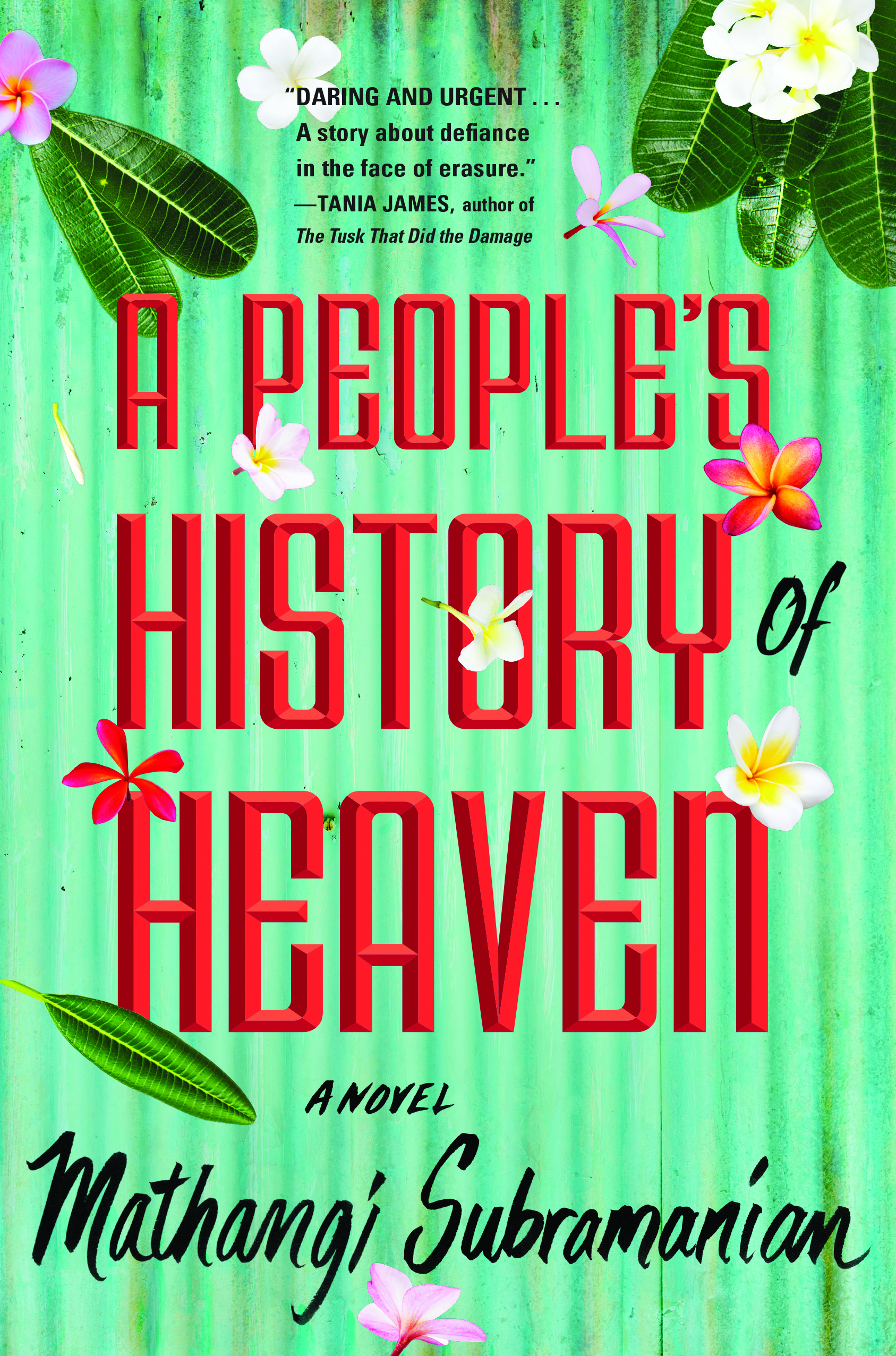
Format: 304 pp., cloth; Size: 5.7 x 8.3″; Price: $26.95; Publisher: Algonquin; Population of Bangalore in 2017: 12.34 million; Estimated number of population living in slums: about 20%; Another book by the author: ; Representative Passage: “They’re wrong, of course. There are plenty of secrets in Heaven. Secrets that hide in pots and pans, waiting for an excuse to bang and crash and roll and boil. Secrets that soak in pooled-up sunlight, watching the world with half-moon eyes. Secrets that lunge out of doorways, wind around windowsills, baring their fangs, making sure they are seen. Secrets shaped like the space between stars, the edges of shadows, the bottoms of clouds. Hues and textures that are woven so tightly into our vision that they are easily missed, even when they are right there, right in plain sight.”
Central Question: Who defends the slums?
It’s easy to imagine the landscape of a slum: a string of shanties with aluminum roofs, open sewers, and rats nests of wires strung from electric poles to feed siphoned power. But what about its inhabitants? The structures of modern capital have kept these people at such a distance from us that a ready-made image does not come to mind. At best, these people come to us as so hazy outlines in a prefabricated cityscape.

Mathangi Subramanian, author of the 2016 young adult novel Dear Mrs. Naidu, vividly portrays these lives in her new novel, A People’s History of Heaven. Heaven is a constellation of stories about Swargahalli, a Bangalore slum at whose entrance hangs a sign that once proclaimed the slum’s name. By the time the novel opens, that sign has broken, so that it reads simply “Swarga”—the Sanskrit word for heaven. Swarga provides the novel’s narrative spine: each chapter tells the story of one of the girls and women living on the margins of the gleaming tech hub of Bangalore. These include Joy, a girl coming to terms with her transgender identity; the hinterland migrant Padma; and Janaki, the school headmaster who keeps all the girls together.
These women live in a city that has experienced development and displacement at a rapid clip. It’s a place where, as Subramanian writes, “If you ask our mothers, they’ll tell you Bangalore has just one problem: engineers.” Tech money and poverty seem to go hand-in-hand. In focusing on the women in these spaces, Subramanian acknowledges those twice erased by their poverty and their gender. A recent report from the Indian government argued that 63 million women were missing from India due to sex-selected abortion and infanticide. The abject devaluation of female life in South Asia was summed up most pointedly by Mahasweta Devi in her short story “Giribala:” “A daughter born. To husband or death. She’s already gone.”
Heaven, perhaps like all slums, was never supposed to be permanent. It was “a for-now kind of place, not a forever kind of place. A square of dirt to tide a family over until something better came along.” But, in time, the for-now place grew more and more permanent:
No one knew that Heaven would outlast the squat brick homes bordering the empty lot, the barely paved lanes where children played cricket and rode their bicycles to school. That those homes and lanes would flatten and crackle and burst into parking lots and shoe stores, breweries and offices. Into hospitals specializing in diseases contracted by people who eat too much, work too little.
A city’s expansion often occurs at the expense of those living at its fringes. The conflict in Subramanian’s book revolves around the arrival of government bulldozers ready to demolish Heaven to make way for more of the gleaming city. Such an experience is nearly universal in post-colonial India. As the Dalit poet and activist Vilas Ghogre put it in his folk song, “Katha Suno Re Logon” (“O People, listen to this story,” translation by author):
Now listen to the breaking news
Of the government’s dealings
To keep the rich happy
We’ve been made the villain
They’ve passed a law
And we’ve been found guilty
The police
Mercilessly destroy our homes
And there will be a three-year sentence
On top of beatings
Maybe it’s the prosaicness of slum demolition that causes Subramanian to relegate this conflict to the novel’s background. In its place are the stories of the girls themselves—their origins, interests, home lives, love lives, and dreams. Subramanian foregrounds the stuff that makes these girls human, rather than a mass of lumpen slum-dwellers.
Bangalore is a city filled with contradictions born out of immense shifts in generational wealth. These contradictions have been explored by a handful of writers. Vivek Shanbhag’s Ghachar Ghochar comes to mind, as do the Dalit writer Du Saraswathi’s stories. Her short story “Tip” opened by contrasting wealth with the detritus it creates. “The ‘Festival of Bengaluru’ had generated a huge amount of garbage and multiplied the sweeping tasks,” Saraswathi wrote. Narratives from below have the exquisite ability to capture wealth’s gleaming edifice as well as the concomitant defilement of everything that surrounds it.
A Peoples History of Heaven is no exception, but it’s also so much more than an ethnography of a changing city. The narration unfolds from the anonymous second-person—the reader is never told who is wielding the “we” in the story’s telling. The book opens with a defiant invocation: “Our houses may break, but our mothers won’t. Instead, they form a human chain, hijabs and dupattas snapping in the metallic wind, saris shimmering in the afternoon sun.” This “we” is every girl in Heaven crying out in a clear voice: listen to what we have to say about ourselves!
The book’s strength lies in Subramanian’s detailed portrayals of a diverse array of lives. In describing Joy’s realization of her transgender identity, Subramanian never rushes; instead, she lingers in the dynamics of self-exploration, religion, and family. Joy was born Anand, a boy who “stole his mother’s kohl and painted his eyes like a film star’s.” He was also born a Dalit. It is this experience that compels Anand’s mother to convert to Christianity. During the conversion ceremony, Anand comes out and is rechristened as Joy, an event met with comfort and surprise by her mother: she is happy to have finally found “A god who does not punish women for wanting daughters instead of sons.”
Throughout this story, the particularity of Joy’s gender identity is not subsumed by her cultural identity. Joy first realizes that she identifies as a girl, and the reader is allowed to take part in this realization, refashioning, and coming out. It is only later that the reader joins Joy in understanding what it means to be transgender in South Asia, and the way in which this identity intersects with that of the subcontinent’s historically marginalized Hijra community (recognized only in 2014 by the Government of India as the third gender):
But Joy? She watches and watches and watches until she sees past the magic, through the superstition. Sees how the hijras count their change before buying something to eat … How they pretend to ignore the innuendos that rattle like gravel from the tongues of dragon-mouthed men. Hot and rough and smoldering.
A People’s History does more than just showcase the girls’ lives. Subramanian seems suspicious of that kind of showcasing. Throughout the book, a white woman wanders with a camera as she to document the slum’s demolition. One of the girls, Rukshana, rails at the photographer’s presence. “She’s not even asking permission,” she cries. “It’s like she thinks she can do whatever she wants with us. Like we don’t even exist.”
Near the end of the book, the girls concoct a plan to save the slum by playing at the photographer’s appetite for poverty’s spectacle. One quips: “A blind girl, a boy with a crooked spine, and a hijra-in-training? All standing in a pile of rubble? … Of course she’s coming.” It’s hard not to imagine the photographer as a stand in for an American readership: the foreigner ready to take a look, unconsciously wanting to feel the aura of a savior.
Thankfully, Subramanian does not allow the observer to stand back and gawk. The novel tenderly guides the reader into and through the struggles of lives lived at the margins, with a sensitivity to experience that can’t be reduced to an apolitical and static image of slum life. If anything, Subramanian deftly explores what political solidarity can look like. While the foreign photographer “clutches her camera so hard that he skin on the top of her knuckles changes color,” the girls find that “when we close our fists, our skin stays exactly the same. Like our bodies are already the color of crisis.”
It would be easy for a reader not familiar with the dynamics of South Asian culture and history to feel lost in this narrative. Subamanian’s use of explanatory exposition (“Deepa was born on Deepavali, the festival of lights,” she informs the reader early in the book) is ostensibly for a readership not exposed to these elements in their own lives. Subramanian also lets her characters express themselves in their own idiom, though. Oftentimes, simple turns of phrases remind the reader of these characters’ cultural contexts. Padma, the headstrong daughter of displaced hinterland migrants, comes to Bangalore ready to fight for her own education. In the process, she finds that the city slowly changes who she once was. Padma’s disappearing accent, for example, is described using the language of daily food staples: it “water[s] down, getting to be less ragi mudde and more sopu saru.” An American audience can think through the watering down of an accent easily enough, but the metaphor is made richer as one imagines a thick ball of finger millet dissolving into a piping bowl of greens and toor dal.
“In Heaven,” Subramanian writes, “anger is not about any one person. It’s about the whole world. The people around you are just close enough to take aim.” A People’s History of Heaven does not reduce its characters to dozens of fists raised in the air, but instead gives a full account of the extraordinary lives that stand shoulder-to-shoulder in the wreckage of a wealthy city, ready to fight against the bulldozers upon the horizon.




